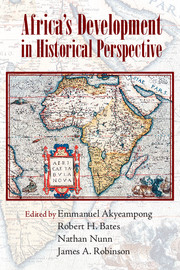Book contents
- Frontmatter
- Contents
- Author Biographies
- Acknowledgments
- Introduction
- Part I La Longue Durée
- 1 Africa in World History before ca. 1440
- 2 Reversal of Fortune and Socioeconomic Development in the Atlantic World
- 3 The Impact of Malaria on African Development over the Longue Durée
- 4 African Population, 1650–2000: Comparisons and Implications of New Estimates
- Part II Culture, Entrepreneurship, and Development
- Part III Institutions
- Part IV External Forces
- Index
- References
2 - Reversal of Fortune and Socioeconomic Development in the Atlantic World
A Comparative Examination of West Africa and the Americas, 1400–1850
Published online by Cambridge University Press: 05 September 2014
- Frontmatter
- Contents
- Author Biographies
- Acknowledgments
- Introduction
- Part I La Longue Durée
- 1 Africa in World History before ca. 1440
- 2 Reversal of Fortune and Socioeconomic Development in the Atlantic World
- 3 The Impact of Malaria on African Development over the Longue Durée
- 4 African Population, 1650–2000: Comparisons and Implications of New Estimates
- Part II Culture, Entrepreneurship, and Development
- Part III Institutions
- Part IV External Forces
- Index
- References
Summary
The comparatively poor performance of the economies of sub-Saharan Africa in the current global economy has been a challenge to scholars and policy makers alike. Economic historians, economists, and political scientists have struggled to understand the puzzle of sub-Saharan African economic development with little success. Without helpful guidance from economic historians and economists, policy makers have often applied ill-informed policy prescriptions with disastrous outcomes. For a while, economic historians seem to have abandoned sub-Saharan Africa out of frustration (Hopkins 2009). Happily, there appears to be a turnaround; economic historians are returning to sub-Saharan Africa as the growing popularity of globalization has helped to focus attention, once again, on long-run historical processes as a source of knowledge for the understanding of contemporary situations (Inikori 2007a). We have begun to see imaginatively articulated articles seeking to explain long-run development processes in sub-Saharan Africa.
This welcome development, however, appears unconnected, or at least not seriously connected, to a major historiographical development with much potential for a clearer understanding of the long-run development process in western Africa. As part of the growing globalization discourse, Atlantic world history is now one of the fastest growing fields of historical scholarship (Bailyn 2005; Canizares-Esguerra and Seeman 2007; Coclanis 2005; Eltis, Lewis, and Sokoloff 2004; Inikori 1979, 2002a; Mancke and Shammas 2005; McCusker and Morgan 2000; O’Rourke and Williamson 1999; Solow 1991). Studying the Atlantic basin as a unit of historical analysis enables us to overcome the myopic view of long-run development processes in the major regions of the Atlantic basin as self-contained and isolated phenomena (Davis 1973, xi). The relational framework of Atlantic world history gives us a clear view of the interconnections between the long-run development processes in the individual subregions of the Atlantic basin. Recent research seeking to explain long-run economic development processes in western Africa has yet to fully incorporate this relational framework of Atlantic world history. Like mainstream European economic historio-graphy (Inikori 2009b), the highly imaginative recent works generally lose sight of the fact that long-run economic development processes in western Africa during the formative centuries, 1450–1850, were essentially part of an integrated historical process in the Atlantic basin. If we are not fully conscious of this fact, we are unlikely to accurately identify the causal factors in the process, properly understand how they operated and interacted with other factors, and assign to them their correct causal weights.
- Type
- Chapter
- Information
- Africa's Development in Historical Perspective , pp. 56 - 88Publisher: Cambridge University PressPrint publication year: 2014
References
- 5
- Cited by



